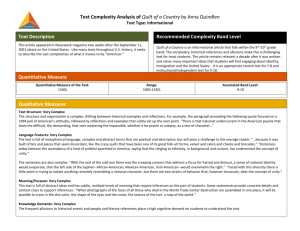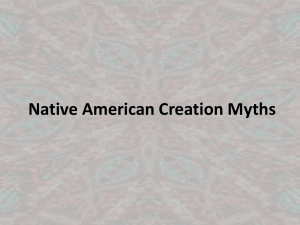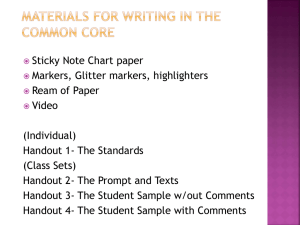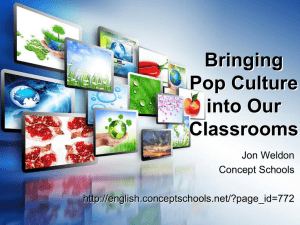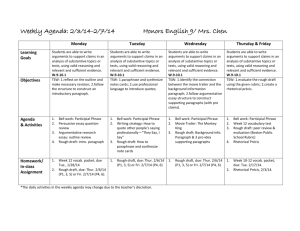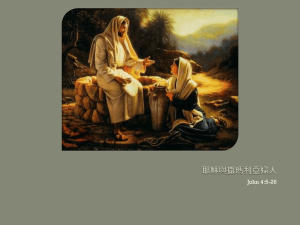Resources: Day 1: Monday http://www.raymondhuber.co.nz/wp
advertisement
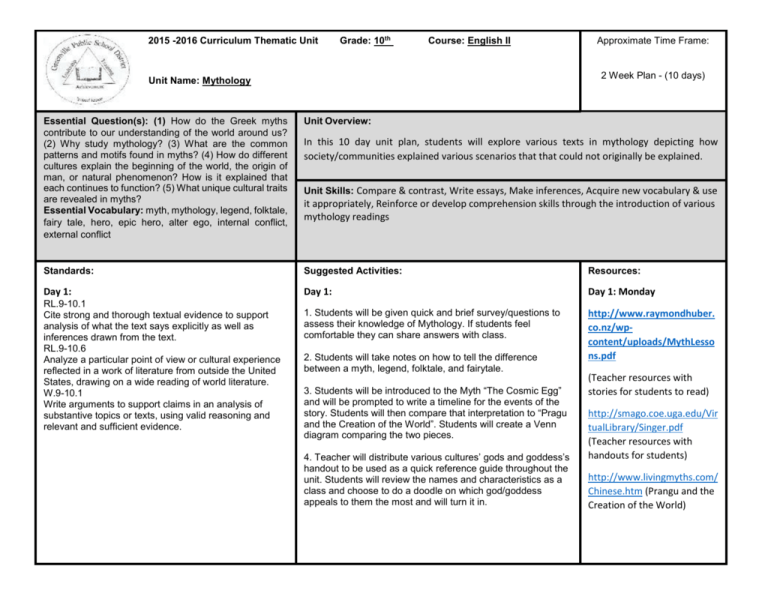
2015 -2016 Curriculum Thematic Unit Grade: 10th Course: English II Approximate Time Frame: 2 Week Plan - (10 days) Unit Name: Mythology Essential Question(s): (1) How do the Greek myths contribute to our understanding of the world around us? (2) Why study mythology? (3) What are the common patterns and motifs found in myths? (4) How do different cultures explain the beginning of the world, the origin of man, or natural phenomenon? How is it explained that each continues to function? (5) What unique cultural traits are revealed in myths? Essential Vocabulary: myth, mythology, legend, folktale, fairy tale, hero, epic hero, alter ego, internal conflict, external conflict Unit Overview: Standards: Suggested Activities: Resources: Day 1: Day 1: Day 1: Monday 1. Students will be given quick and brief survey/questions to assess their knowledge of Mythology. If students feel comfortable they can share answers with class. http://www.raymondhuber. co.nz/wpcontent/uploads/MythLesso ns.pdf RL.9-10.1 Cite strong and thorough textual evidence to support analysis of what the text says explicitly as well as inferences drawn from the text. RL.9-10.6 Analyze a particular point of view or cultural experience reflected in a work of literature from outside the United States, drawing on a wide reading of world literature. W.9-10.1 Write arguments to support claims in an analysis of substantive topics or texts, using valid reasoning and relevant and sufficient evidence. In this 10 day unit plan, students will explore various texts in mythology depicting how society/communities explained various scenarios that that could not originally be explained. Unit Skills: Compare & contrast, Write essays, Make inferences, Acquire new vocabulary & use it appropriately, Reinforce or develop comprehension skills through the introduction of various mythology readings 2. Students will take notes on how to tell the difference between a myth, legend, folktale, and fairytale. 3. Students will be introduced to the Myth “The Cosmic Egg” and will be prompted to write a timeline for the events of the story. Students will then compare that interpretation to “Pragu and the Creation of the World”. Students will create a Venn diagram comparing the two pieces. 4. Teacher will distribute various cultures’ gods and goddess’s handout to be used as a quick reference guide throughout the unit. Students will review the names and characteristics as a class and choose to do a doodle on which god/goddess appeals to them the most and will turn it in. (Teacher resources with stories for students to read) http://smago.coe.uga.edu/Vir tualLibrary/Singer.pdf (Teacher resources with handouts for students) http://www.livingmyths.com/ Chinese.htm (Prangu and the Creation of the World) 2015 -2016 Curriculum Thematic Unit Grade: 10th Course: English II 2 Week Plan - (10 days) Unit Name: Mythology Day 2: RI 9-10.1 & RL.9-10.1 Cite strong and thorough textual evidence to support analysis of what the text says explicitly as well as inferences drawn from the text. RI & RL.9-10.6 Analyze a particular point of view or cultural experience reflected in a work of literature from outside the United States, drawing on a wide reading of world literature. W.9-10.1 Write arguments to support claims in an analysis of substantive topics or texts, using valid reasoning and relevant and sufficient evidence. W.9-10.2 Write informative/explanatory texts to examine and convey complex ideas, concepts, and information clearly and accurately through the effective selection, organization, and analysis of content. Day 3: RL.9-10.1 Cite strong and thorough textual evidence to support analysis of what the text says explicitly as well as inferences drawn from the text. RL.9-10.6 Analyze a particular point of view or cultural experience reflected in a work of literature from outside the United States, drawing on a wide reading of world literature. Approximate Time Frame: Day 2: 1. Students will take notes on mythology in their interactive notebook. 2. Students will read the article “10 Universal Myths of the Ancient World” and have a class discussion on what myths students have heard of/find interesting/never heard of before. 3. Students will read the news article “Debunking the Key Myths about Creativity” as a class. Students will respond to article in their news journal where they will summarize the article and make personal/world connections. 4. Students will gather in a circle for a Socratic Seminar to see if there are any connections that can be made of the Greek myths and our society today, and to discuss any thoughts/feelings in relation to the article. 5. If there is time left in class, students will read individually/in pairs or as a class the story “Damon and Pythias” in the English 10 textbook pg 822-825. The class will briefly discuss what happened so they understand what happened in the story, and then they will complete all the questions at the end of the text. Students will turn in assignment once finished. Day 3: 1. Students will read “Cupid and Psyche” as a class in the textbook pg (844-851). Before the reading, teacher will ask students what they think the story is about based on the picture and the title. Class will read story popcorn style and teacher will check for student understanding as needed. 2. Students will then do a pair share with their partner/nearest student and their thoughts of the reading-what surprised them and what did they expect. Content Connections: 2015 -2016 Curriculum Thematic Unit Grade: 10th Course: English II 2 Week Plan - (10 days) Unit Name: Mythology RL.9-10.7 Analyze the representation of a subject or a key scene in two different artistic mediums, including what is emphasized or absent in each treatment W.9-10.1 Write arguments to support claims in an analysis of substantive topics or texts, using valid reasoning and relevant and sufficient evidence. Approximate Time Frame: Day 3: continued Day 3: Wednesday 3. Once students are finished with story, they will complete questions at the end of the text (Can be done individually or in pairs). “Cupid and Psyche” English 10 textbook pg. 844-851 4. Teacher will then put on “Beauty and the Beast” and students will write a ½-1 page comparison of the movie and the story. If the movie is too long, students will finish watching the movie and make the comparisons the following day. Disney’s “Beauty and the Beast” movie W.9-10.2 Write informative/explanatory texts to examine and convey complex ideas, concepts, and information clearly and accurately through the effective selection, organization, and analysis of content. Day 4: RI & RL.9-10.1 Cite strong and thorough textual evidence to support analysis of what the text says explicitly as well as inferences drawn from the text. RI & RL.9-10.6 Analyze a particular point of view or cultural experience reflected in a work of literature from outside the United States, drawing on a wide reading of world literature. RL.9-10.7 Analyze the representation of a subject or a key scene in two different artistic mediums, including what is emphasized or absent in each treatment W.9-10.1 Write arguments to support claims in an analysis of substantive topics or texts, using valid reasoning and relevant and sufficient evidence. Day 4: Thursday Day 4: Thursday 1. Class will finish the “Beauty and the Beast” movie and make ½-1 page comparisons between the text and the movie. “Cupid and Psyche” English 10 textbook pg. 844-851 2. Students will then read the news article “Prehistoric Fossil May have Inspired Greek Myths” as a class. Students will respond to article in their news journal where they will summarize the article and make personal/world connections. Disney’s “Beauty and the Beast” movie 3. Students will gather in a circle for a Socratic Seminar to see how/why Greeks came up with their myths, and to discuss any thoughts/feelings in relation to the article. http://news.discovery.com/hist ory/archaeology/fossilancient-greeks-mammal110331.htm (article) 2015 -2016 Curriculum Thematic Unit Grade: 10th Course: English II Approximate Time Frame: 2 Week Plan - (10 days) Unit Name: Mythology W.9-10.2 Write informative/explanatory texts to examine and convey complex ideas, concepts, and information clearly and accurately through the effective selection, organization, and analysis of content. Day 5: Day 5: Day 5: RL.9-10.1 Cite strong and thorough textual evidence to support analysis of what the text says explicitly as well as inferences drawn from the text. 1. Students will read as a class in popcorn reading “Arachne” and will discuss what happened in the story. http://www.augusta.k12.va.us/ cms/lib01/VA01000173/Centri city/Domain/1088/arachne.PD F (Story and questions) RL.9-10.6 Analyze a particular point of view or cultural experience reflected in a work of literature from outside the United States, drawing on a wide reading of world literature. W.9-10.1 Write arguments to support claims in an analysis of substantive topics or texts, using valid reasoning and relevant and sufficient evidence. W.9-10.2 Write informative/explanatory texts to examine and convey complex ideas, concepts, and information clearly and accurately through the effective selection, organization, and analysis of content. 2. Students will then complete questions at the end of the text (individually or in pairs) and turn their work in once they’re done. 3. Students will then compare “Arachne” and “Cupid and Psyche” in a timed essay (20-30 minutes) on how Gods and Goddesses would affect the lives of mortals and what lessons that taught the Greek community. Is there any comparison we can make in our own community? How so? 4. Students will be assigned homework in which they will create a mask to represent a character in their short myth that they came up with. They need to be able to explain why they had their mask look the way it does (out of any materials of their choice) and turn in their brief myth (typed 1-3 pages). Their myth will need to resemble characteristics of myths explored in class and MUST be an original piece. Assignment must be brought in on day 6. http://www.yale.edu/ynhti/curri culum/units/1983/2/83.02.08.x .html (resource for students to help make their myth) Content Connections: 2015 -2016 Curriculum Thematic Unit Grade: 10th Course: English II Approximate Time Frame: 2 Week Plan - (10 days) Unit Name: Mythology Day 6: Day 6: Day 6: Monday RL.9-10.1 Cite strong and thorough textual evidence to support analysis of what the text says explicitly as well as inferences drawn from the text. 1. Students will read “Why the Tortoise’s Shell is not Smooth” as a class. Before the reading, teacher will ask students how they think the tortoise’s shell became unsmooth. Class will read story popcorn style and teacher will check for student understanding as needed. “Why the Tortoise’s Shell is Not Smooth” RL.9-10.6 Analyze a particular point of view or cultural experience reflected in a work of literature from outside the United States, drawing on a wide reading of world literature. 2. Students will then do a pair share with their partner/nearest student and their thoughts of the reading-what surprised them and what did they expect. http://www.beatricepublicscho ols.org/pages/uploaded_files/ 21%20Unit%206%20Tortoise. pdf (Questions) 3. Once students are finished with story, they will complete questions at the end of the text (Can be done individually or in pairs). Day 7: Tuesday Day 7: RI & RL.9-10.1 Cite strong and thorough textual evidence to support analysis of what the text says explicitly as well as inferences drawn from the text. RI RL.9-10.6 Analyze a particular point of view or cultural experience reflected in a work of literature from outside the United States, drawing on a wide reading of world literature. Day 7: 1. Students will read the story “Persephone and Demeter” popcorn style as a class. After students are done reading, students will complete questions (individually or in pairs) for 45 min max. Students will turn questions in when completed. If they don’t finish they will have to complete questions at home. 2. Students will read the news article “Researchers Uncover Ancient Mask of Pagan God Pan in Northern Israel” as a class. Students will respond to article in their news journal where they will summarize the article and make personal/world connections. http://myths.e2bn.org/mythsa ndlegends/textonly19837demeter-and-her-daughterpersephone.html (Persephone & Demeter story) http://www.cnhs.org/ourpages /auto/2014/3/27/39742542/Pe rsephones%20Myth%20Ques tions.pdf (story questions) http://www.huffingtonpost.com /2015/03/24/pan-maskisrael_n_6925070.html (article) 2015 -2016 Curriculum Thematic Unit Grade: 10th Course: English II 2 Week Plan - (10 days) Unit Name: Mythology W.9-10.1 Write arguments to support claims in an analysis of substantive topics or texts, using valid reasoning and relevant and sufficient evidence. Approximate Time Frame: 3. Students will gather in a circle for a Socratic Seminar to see if there are any connections that can be made of myths and our society today, the importance of uncovering ancient mythological emblems, and to discuss any thoughts/feelings in relation to the article W.9-10.2 Write informative/explanatory texts to examine and convey complex ideas, concepts, and information clearly and accurately through the effective selection, organization, and analysis of content. Day 8: CCSS.ELA-Literacy.RL.9-10.1 Cite strong and thorough textual evidence to support analysis of what the text says explicitly as well as inferences drawn from the text. CCSS.ELA-Literacy.RL.9-10.6 Analyze a particular point of view or cultural experience reflected in a work of literature from outside the United States, drawing on a wide reading of world literature. Day 8: Wednesday 1. Students will be reading 4 Native American creation myths. Students will popcorn read as a class and discuss what had happened in the myths. After students are done, students will be given a project that they will finish till the bell rings. 2. Project: In Gods We Trust: By reading at least four different creation myths of different Native American tribes, you will begin to realize the many different names given to the God(s) of Native American culture. Create a poster (provided by the teacher) that includes the name of the Native American tribe, the name of the God(s) they believe in, and what the God(s) is responsible for. Use pictures or drawings to enhance the poster. Day 8: Wednesday http://www.bibliotecapleyades .net/mitos_creacion/esp_mito screacion_13.htm (Native American myths) Content Connections: 2015 -2016 Curriculum Thematic Unit Grade: 10th Course: English II 2 Week Plan - (10 days) Unit Name: Mythology Day 9: RI & RL.9-10.1 Cite strong and thorough textual evidence to support analysis of what the text says explicitly as well as inferences drawn from the text. RI & RL.9-10.6 Analyze a particular point of view or cultural experience reflected in a work of literature from outside the United States, drawing on a wide reading of world literature. W.9-10.1 Write arguments to support claims in an analysis of substantive topics or texts, using valid reasoning and relevant and sufficient evidence. W.9-10.2 Write informative/explanatory texts to examine and convey complex ideas, concepts, and information clearly and accurately through the effective selection, organization, and analysis of content. Approximate Time Frame: Day 9: Day 9: 1. Students will be given a Norse Mythology PowerPoint where they are expected to take quick and basic notes. http://www.vikingmythology.com/ (Norse Background) 2. After notes, students will read the myth of “Odin and the Mead of Poetry” as a class popcorn style. Students will discuss what happened in the myth to check for understanding. Students will continue the article to read how ancient people interpreted the myth and how the myth contributes to society today. 3. Students will read the news article “Word Play: Old Myths and Teen Heroes” as a class. Students will respond to article in their news journal where they will summarize the article and make personal/world connections. http://norsemythology.org/tales/themead-of-poetry/ (Odin & the Mead of Poetry with modern comparisons/interpretations) http://articles.latimes.com/201 1/may/29/entertainment/lacaw-word-play-20110529 (article) 4. Students will gather in a circle for a Socratic Seminar to see if there are any connections that can be made of the Greek myths and our society today, if Greek mythology has contributed to various other books/stories that are considered modern day, and to discuss any thoughts/feelings in relation to the article. Content Connections: 2015 -2016 Curriculum Thematic Unit Grade: 10th Course: English II 2 Week Plan - (10 days) Unit Name: Mythology Day 10: RI & RL.9-10.10 By the end of grade 10, read and comprehend literature, including stories, dramas, and poems, at the high end of the grades 9-10 text complexity band independently and proficiently. W.9-10.1 Write arguments to support claims in an analysis of substantive topics or texts, using valid reasoning and relevant and sufficient evidence. W.9-10.2 Write informative/explanatory texts to examine and convey complex ideas, concepts, and information clearly and accurately through the effective selection, organization, and analysis of content. Approximate Time Frame: Day 10: 1. Students will be given a writing prompt for an in class timed essay (30 minutes). Students will write on how mythology has influenced society/communities/modern day culture today. Students should reference the pieces we have read/discussed in class, as well as any other pieces that come to mind. The expectation is that they will write a 5 paragraph essay in 30-45 minutes. 2. Students will then be given a homework assignment that they will begin on in class on a Greek and Goddess Portrait (whatever they don’t finish in class will be completed for homework): Students work in groups to compose a portrait of a god or goddess of their choice. No one in the class can choose the same god or goddess. Portrait will include: a picture (drawn or printed), symbols associated with the deity, and a description of how that deity represents the values of our society. Students should develop their portraits from their opinions and interpretations of the gods and goddesses from the various stories read in class. Students will bring final project on the next day. Content Connections:


